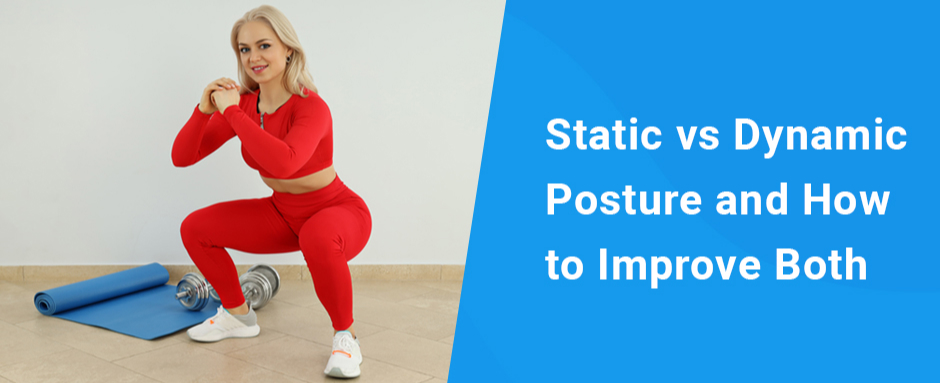
Good posture has fabulous cosmetic benefits, making you look younger, taller and more confident. But there is more to perfect posture than how others perceive you. Good posture has lifelong health benefits that can dramatically improve your quality of life and even help you live longer!
Learn the difference between static and dynamic posture, and steps you can take today to optimize your personal posture for better health, improved performance and a rock star physique.
Put in the simplest terms, posture is defined by how your joints align relative to the force of gravity when you are standing or sitting (static posture), and when your body is in motion (dynamic posture).
Suboptimal postural alignment requires more energy to sustain, and puts more stress on your joints, increasing your risk of injury and causing long-term structural damage. Poor posture can interfere with the smooth gliding of nerves among soft tissues and rigid structures, causing pain and inhibiting movement.
Poor posture contributes to multiple health conditions, such as:
Back pain
Neck pain
Shoulder pain and dysfunction
Impaired breathing
Jaw pain
Headaches
Sexual dysfunction
Reproductive issues
Constipation
Bladder and bowel issues
Pelvic pain and dysfunction
Joint pain in the hips, knees, ankles and feet
Balance issues
Neuromuscular disorders
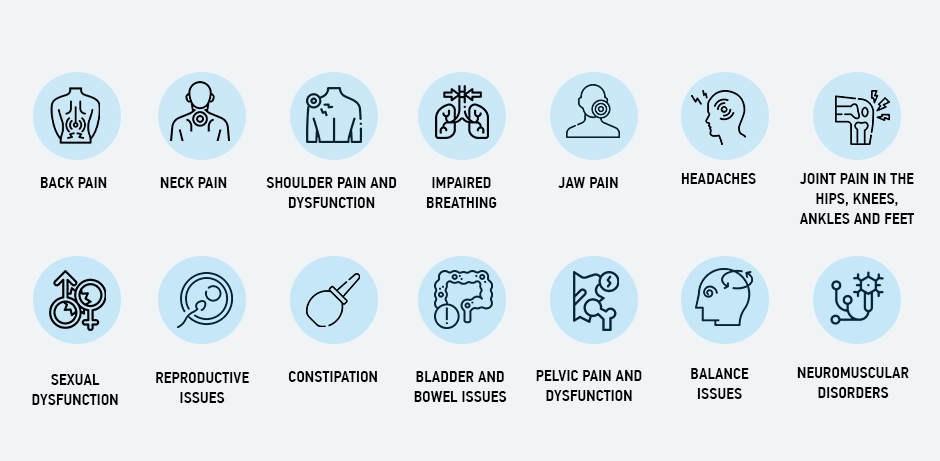
There are several things you can do right away to improve your posture, with long-term strategies for maintaining healthy posture throughout your lifetime.
Your skeletal structures would be nothing but a heap of bones without your muscles, fascia and connective tissues to hold them in place. Postural alignment is achieved by coordinated muscle tension throughout your body. As your muscles contract, they pull against rigid structures to hold them in place.
Humans begin to develop posture as soon as we are born. During the first year of life, the stages of infant development coincide with milestones in movement, such as lifting the head, rolling over, pushing up, creeping, crawling, and eventually standing and walking.
Developmental milestones are innately programmed into human software, and they can be reactivated by dynamic neuromuscular stabilization (DNS) techniques. Infant development is a bodybuilding show in action as muscles, bones and connective tissues become strong enough to defy gravity and master locomotion.
When early development progresses without impedance, good posture is naturally established. However, many things can undermine good posture over time, resulting in suboptimal motor strategies that cause pain and dysfunction.
Causes of poor posture include:
Sedentary lifestyle
Being overweight or obese
Repetitive movement patterns that overuse muscles on one side of the body
Excessive sitting
Activities that cause a prolonged head-forward posture, like reading and using electronic devices
Old injuries that were never properly rehabilitated
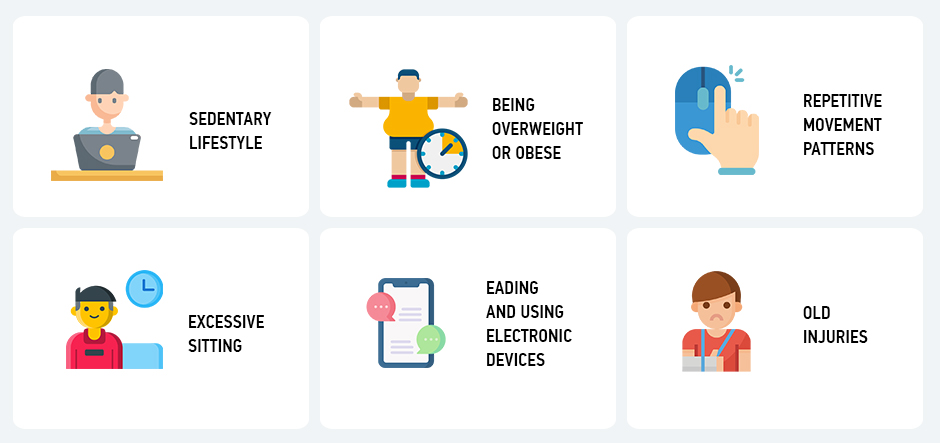
Conscious awareness of how you stand and sit on a daily basis is fundamental to achieving good static posture. What begins as bad habits can eventually cause muscle imbalances that dictate your everyday posture and lead to pain and dysfunction.
Get in the habit of surveying your posture when forced to stand for long periods, such as standing in line. Look for the following postural habits when standing:
Shifting your weight to one leg
Standing with your knees locked out
Allowing your core muscles to relax
Clenching your buttocks
Slumping your shoulders
Tips for achieving good static posture while standing:
Engage your core
Position your ankles directly beneath your hips
Keep your knees slightly bent
Pull up from your ribcage
Lift your chest
Pull your shoulders back and down
Elongate your neck
Keep your chin parallel to the floor
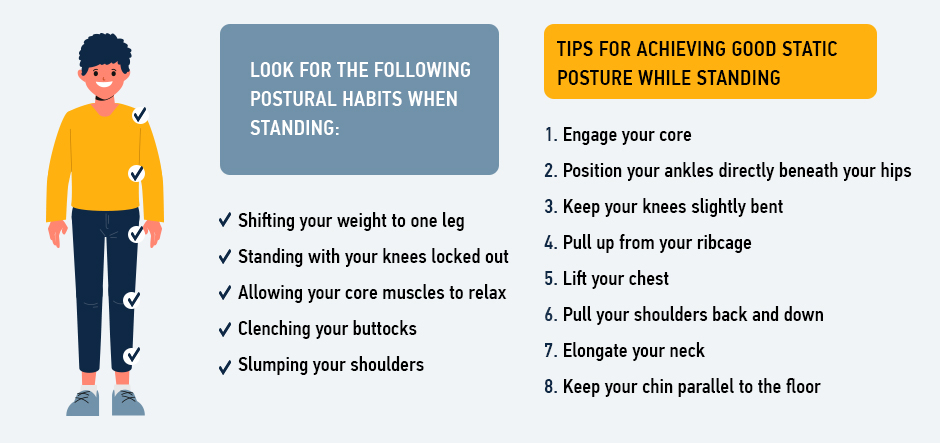
A good example of perfect standing posture is a soldier standing at attention or at ease.
When viewed from a side angle:
Your earlobe should align with your shoulder joint
Your shoulder should align with your hip joint
Your knee should align slightly forward of your hip joint
Your ankle should align slightly behind your knee joint
When viewed from the front or back:
A vertical line along your body’s midline should dissect your body symmetrically into right and left halves
Body weight should be distributed evenly between both feet
Stand with your back against a flat wall and engage your core
Leg your arms hang straight from your shoulders, palms toward your body
Touch your heels, buttocks, elbows, shoulder blades and the back of your head to the wall
Keep your chin parallel to the floor
Maintaining your joint alignment, take a giant step away from the wall
If your alignment feels unnatural or uncomfortable, you have probably developed some poor standing postural habits that need to be corrected
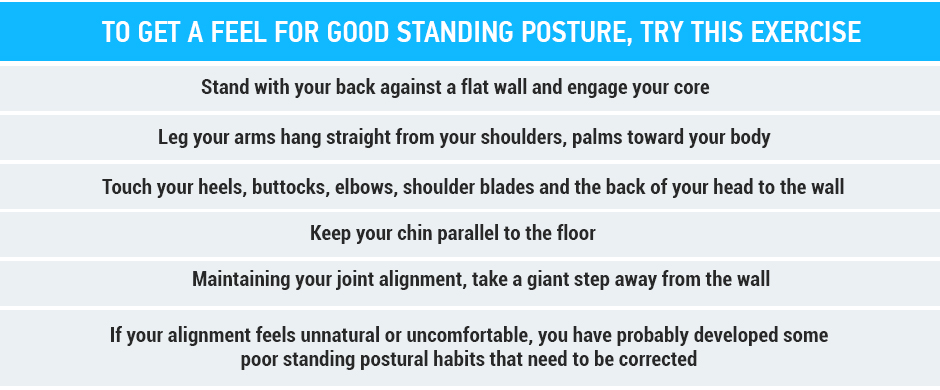
When sitting, look for these postural habits:
Head-forward position, as when looking down at a mobile device
Forward-rounded shoulders and compressed chest cavity
Posterior pelvic tilt with rounded low back
Feet unable to rest on the floor
Hip and knee angle greater than 90º
Align your earlobes with your shoulders and hips
Relax your shoulders back and down, elbows close to your sides
Keep your hips and knees at 90º
Your feet should be flat on the floor, heels down
When keyboarding, keep your elbows at 90º, forearms parallel to the floor, wrists extended
You may need to adjust your workstation to accommodate good sitting posture.

Your static posture creates a foundation for your dynamic posture. When your body is accustomed to being in alignment while standing and sitting, you are more likely to position your body’s center of gravity in optimal ways while in motion.
Factors that influence your dynamic posture include:
Joint mobility. All of your joints should be able to move freely through their functional range of motion. Overly tight muscles and connective tissues, and injuries that were never fully rehabilitated can restrict your joint range of motion, reducing physical performance and increasing your risk of injury. You can restore optimal joint range of motion with physical therapy.
Joint hypermobility. To move optimally, you need both mobility and stability in your joints. It is a balancing act between strong muscles and mobile joints. A biomechanical analysis can measure the balance of muscle tension at your joints, to identify areas that are overly lax and need strengthening. A good physical therapy program can help you achieve the perfect balance of joint stability and mobility.
Coordinated muscle firing patterns. During physical activity, your muscles work together in a coordinated sequence to produce specific movements. Compensation patterns from former injuries, poor static posture, and bad habits can cause muscles to misfire, setting you up for injury and preventing you from performing at your best.

There are many things you can do right away to improve your posture, but without a means to measure your progress, it can be difficult to tell whether your efforts are yielding the desired results.
The human movement specialists at NYDNRehab use advanced technologies to precisely measure joint angles, force loads, muscle firing patterns and other elements that contribute to good posture.
Our high-resolution diagnostic ultrasound equipment lets us identify old injuries that may be contributing to faulty movement strategies. Our 3D gait analysis technologies let us identify and correct deficits in the gait cycle that undermine dynamic posture.
Your posture retraining program may include some or all of the following:
Physical therapy
Chiropractic care
Gait analysis and retraining
Dynamic neuromuscular stabilization (DNS)
Therapeutic Pilates
Record therapy
Dynamic feedback training
Biomechanical analysis
Therapeutic massage
Posture retraining has many benefits that improve your health and contribute to a better quality of life. Improved posture helps you move better, feel better, look better and be more confident. Contact NYDNRehab today to schedule a posture analysis, and begin your journey toward better posture so you can move and perform with grace and confidence.
Resource
Orhan, Emre, Büşra Altın, and Songül Aksoy. “Effect of smartphone use on static and dynamic postural balance in healthy young adults.” American journal of audiology 30.3 (2021): 703-708.
https://pubs.asha.org/doi/abs/10.1044/2021_AJA-20-00210
Vos, Lammert A., Maarten R. Prins, and Idsart Kingma. “Training potential of visual feedback to improve dynamic postural stability.” Gait & Posture 92 (2022): 243-248.
https://www.sciencedirect.com/science/article/abs/pii/S0966636221006263
Dr. Lev Kalika is a world-recognized expert in musculoskeletal medicine. with 20+ years of clinical experience in diagnostic musculoskeletal ultrasonography, rehabilitative sports medicine and conservative orthopedics. In addition to operating his clinical practice in Manhattan, he regularly publishes peer-reviewed research on ultrasound-guided therapies and procedures. He serves as a peer reviewer for Springer Nature.
Dr. Kalika is an esteemed member of multiple professional organizations, including: